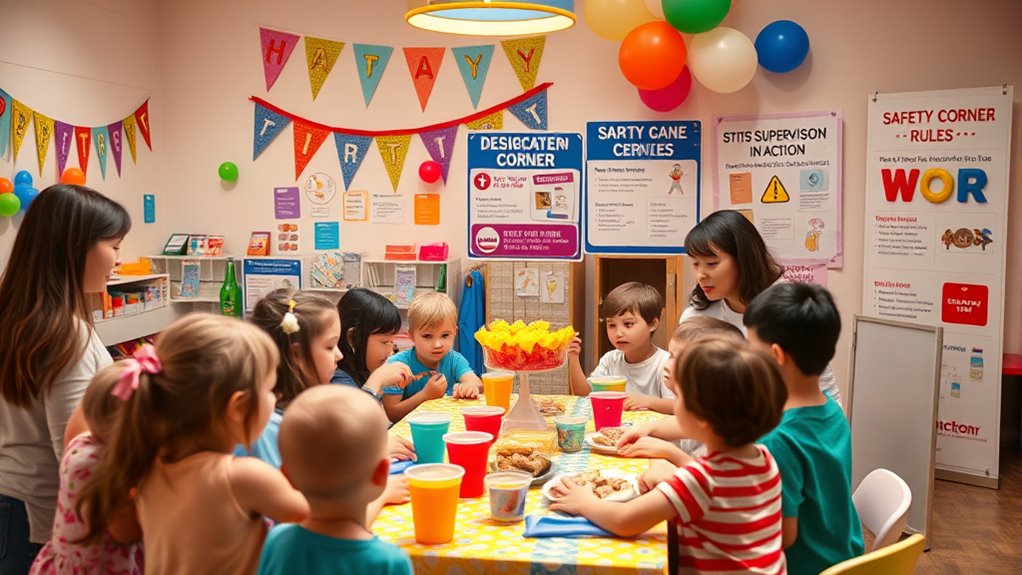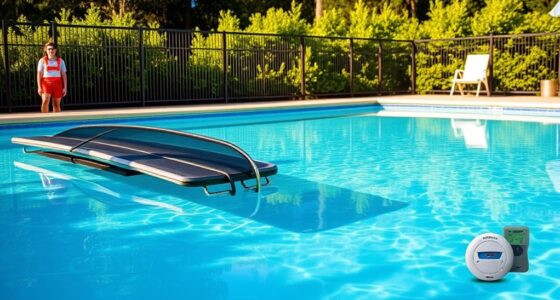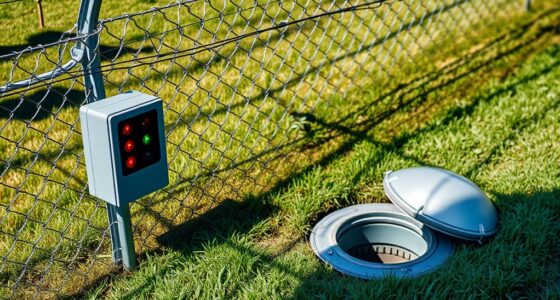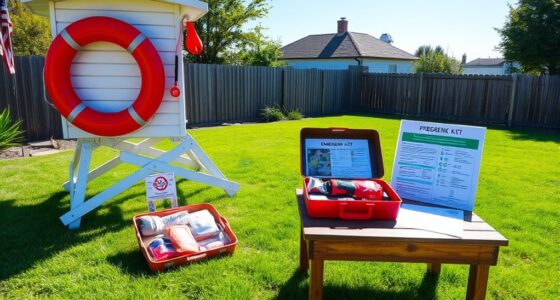To guarantee safe parties, set clear supervision zones with designated areas for different activities and assign responsible monitors to oversee them. Communicate ground rules clearly and enforce them consistently, keeping everyone informed about acceptable behaviors. Keep safety supplies handy, monitor food and drinks to prevent overindulgence, and watch crowd flow to avoid overcrowding. Stay proactive and plan for emergencies—if you want detailed strategies, there’s more to explore below.
Key Takeaways
- Clearly define supervision zones and assign responsible monitors for different areas and activities.
- Communicate safety rules and expectations visibly, enforcing consequences consistently and simply.
- Prepare safety supplies and check environment safety regularly to handle emergencies effectively.
- Use data and incident reports to analyze safety issues, update protocols, and prevent recurring hazards.
- Promote transparency and accountability through detailed incident documentation and continuous safety reviews.
Establish Clear Supervision Zones
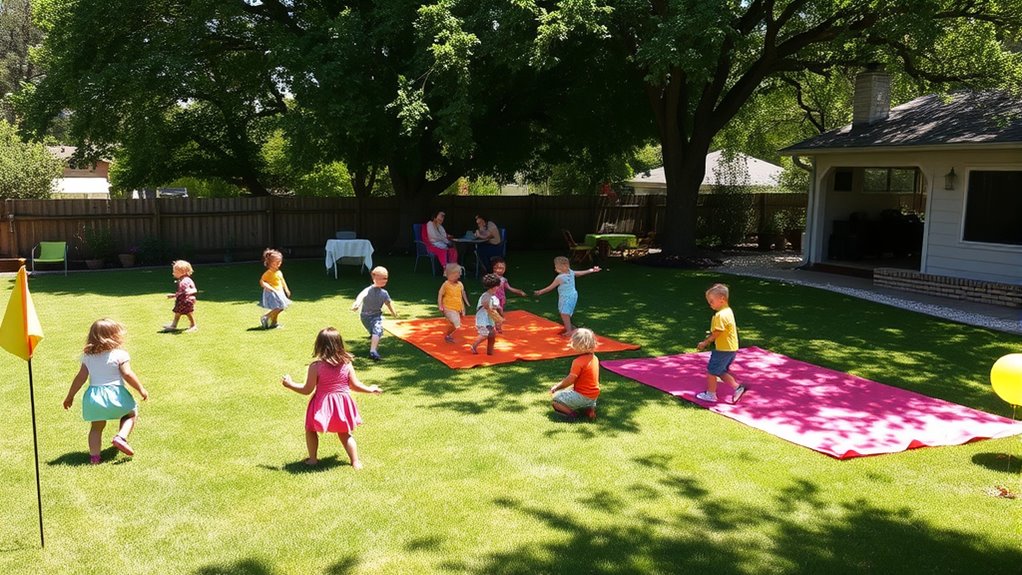
To keep everyone safe, it is essential to establish clear supervision zones around the party area. You should designate specific areas for different age groups or activities, making it easier to monitor everyone effectively. For example, create a dedicated space for children to play, separate from the main gathering or food area. Use barriers or markers, like tape or furniture, to clearly define these zones. Assign responsible adults to each zone, ensuring they stay attentive and approachable. Keep pathways clear for easy movement and quick access in case of emergencies. Regularly check the drivetrain components, such as gears and tires, to ensure safety and proper function during the event. By establishing these zones, you reduce chaotic situations and make supervision more manageable. Clear boundaries help guests understand where they should be, making your party safer and more organized.
Set and Communicate Ground Rules
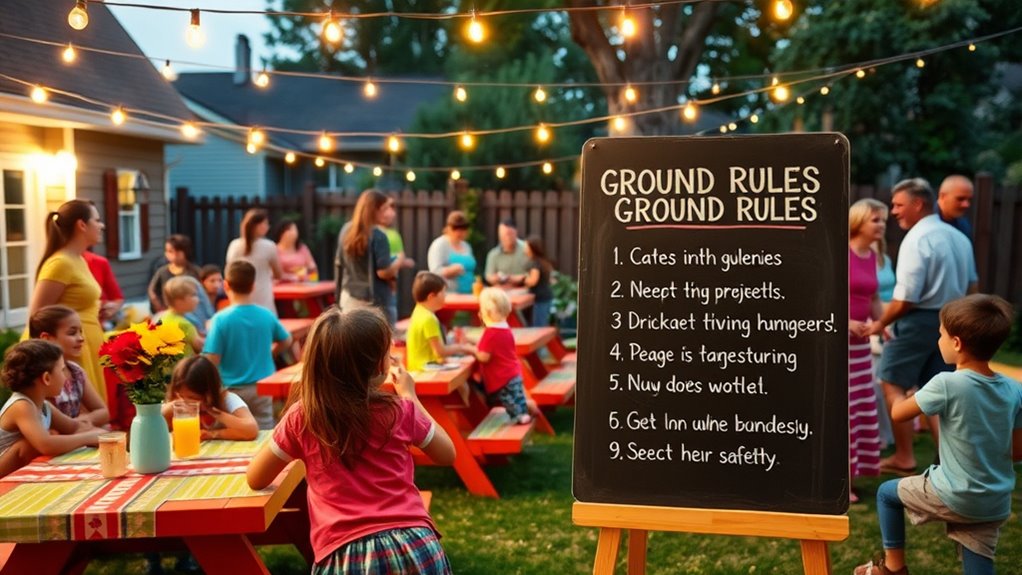
Setting and communicating ground rules is essential for ensuring everyone knows what behavior is expected during the party. Clearly outline what’s acceptable and what’s not, such as respecting others’ space, avoiding excessive alcohol, and maintaining quiet hours. When you communicate these rules upfront, it sets a tone of safety and respect. Make sure everyone understands the consequences of breaking the rules, and don’t hesitate to enforce them consistently. Use simple language and be direct. Post the rules in visible areas or include them in invitations so guests are aware beforehand. When everyone knows the expectations, it reduces misunderstandings and helps prevent trouble. Clear, firm communication creates a safer environment where guests can relax and enjoy themselves responsibly. Incorporating well-defined guidelines can further enhance guest cooperation and safety.
Assign Responsible Chaperones or Monitors

Having responsible chaperones or monitors in place is essential for maintaining safety and order throughout the party. You need trusted adults or designated older teens who can actively supervise guests, enforce rules, and respond quickly to any issues. Assign specific roles, like monitoring entrances, supervising activities, or keeping an eye on alcohol or other restricted items. Clearly communicate expectations to your monitors so they understand their responsibilities and the importance of staying attentive. Make sure they know how to handle common problems calmly and effectively. Having enough responsible people ensures no area or activity is left unsupervised. This proactive approach helps prevent accidents, disputes, or unsafe behavior, giving everyone a safer, more enjoyable experience. Incorporating electric bikes can also be a fun way to promote safe transportation during the event.
Prepare for Emergencies With Safety Supplies
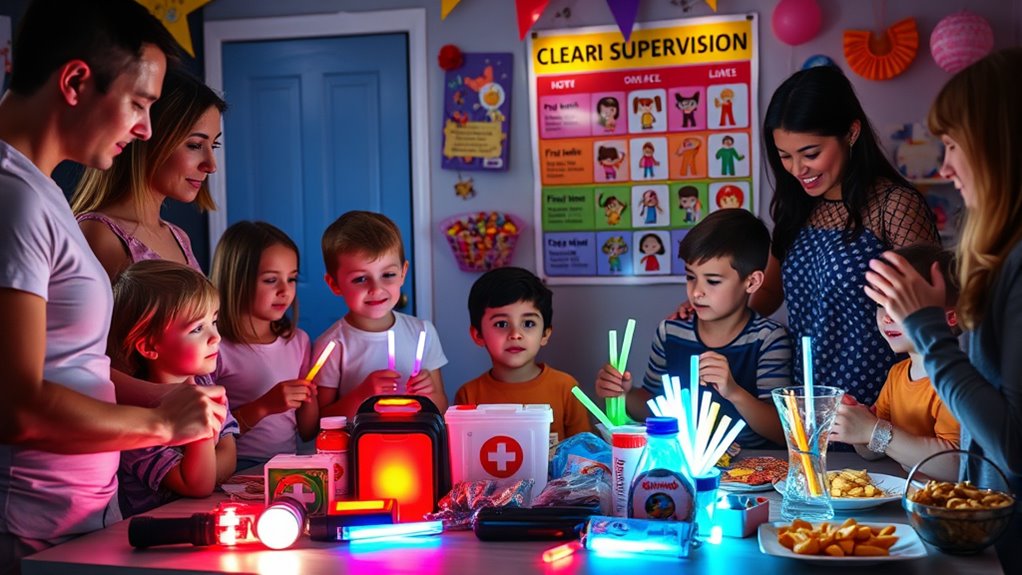
Equipping your party with the right safety supplies guarantees you’re prepared for any unexpected situations. Have a well-stocked kit readily available that includes essentials like bandages, antiseptics, and pain relievers. Consider adding items based on your guests’ needs, such as allergy medications or gloves. Keep supplies organized and easily accessible to respond quickly during emergencies. Here’s a simple checklist to guide you:
| Item | Purpose | Location |
|---|---|---|
| First aid kit | Treat minor injuries | Near entrance |
| Fire extinguisher | Handle small fires | Kitchen or main area |
| Flashlight | Provide light in power outages | Near main entry |
Being prepared with these supplies helps ensure safety and peace of mind for everyone. Ensuring proper contrast ratio in your environment can also improve visibility and safety during emergencies.
Keep an Eye on Food, Drinks, and Crowds

Make certain you keep an eye on how much guests are eating and drinking to prevent overindulgence. Control access points to avoid uninvited or problematic visitors from entering the party. Staying alert helps you manage the crowd and ensure everyone stays safe and comfortable. Being attentive to conflict resolution skills can also help you address any issues that arise promptly and effectively.
Monitor Food Intake
To guarantee everyone stays safe, it’s important to keep a close eye on food, drinks, and the crowd throughout the event. Watch for anyone showing signs of overindulgence or discomfort, and be ready to step in if someone needs help. Keep track of how much alcohol guests are consuming, especially if some have had too much. Make sure food is available and accessible so guests can eat and stay balanced. Monitor the crowd for any signs of agitation or distress, and be prepared to intervene if necessary. By staying alert to these details, you can prevent issues before they escalate, ensuring a safe, enjoyable environment for everyone. Regularly check in with guests and adjust your supervision as needed. Incorporating professional soundscapes and engaging communication can help diffuse tense situations and promote a positive atmosphere.
Control Access Points
Controlling access points is essential to maintaining a safe party environment. By monitoring entrances, exits, and high-traffic areas, you can prevent unwanted guests and quickly respond to emergencies. Keep an eye on food and drinks to reduce the risk of tampering or overconsumption. Consider assigning a dedicated person to oversee key access points to ensure only authorized individuals enter. Use signage or barriers to direct flow and limit overcrowding. Here’s a quick reminder:
| Access Point | Control Measure | Purpose |
|---|---|---|
| Entrance | Guest list check | Prevent uninvited guests |
| Exit | Sign-out station | Track who leaves and returns |
| Food & Drink | Supervised distribution | Reduce tampering and overuse |
| Main Areas | Crowd monitoring | Prevent overcrowding |
| Emergency Exits | Clear signage & access | Ensure quick evacuation |
Staying vigilant at these points keeps your party safe and enjoyable. Properly managing access points helps in maintaining overall safety and order throughout the event.
Follow Up After the Event to Improve Safety Measures
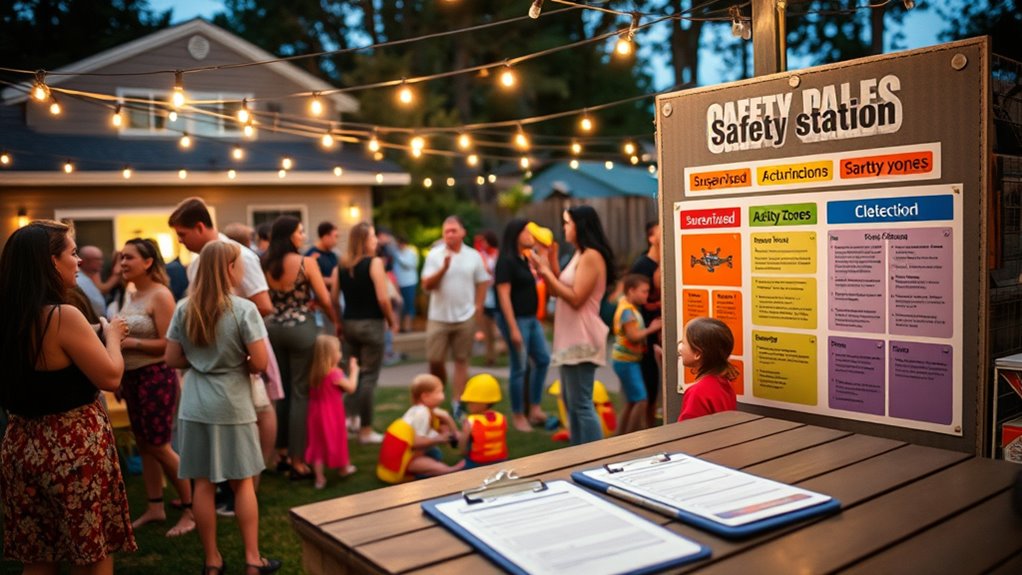
After the event, you should debrief with your staff to gather insights and identify what went well or need improvement. Reviewing incident reports helps you spot patterns and address safety concerns more effectively. These steps make sure your safety measures evolve and make future parties safer for everyone. Additionally, analyzing previous safety incidents can provide valuable lessons to prevent similar issues in the future.
Debrief With Staff
Conducting a thorough debrief with your staff is essential for identifying what went well and pinpointing areas for improvement in safety measures. Gather everyone involved and encourage honest, constructive feedback. Ask specific questions about crowd control, emergency responses, and communication effectiveness. Focus on what procedures worked smoothly and where issues arose. Take detailed notes and look for patterns or recurring concerns. This debrief helps you understand the real-time challenges your team faced and offers insights for future events. Keep the discussion professional and solution-oriented, avoiding blame. By actively listening and documenting feedback, you’ll build a clearer picture of safety strengths and weaknesses. Incorporating data-driven strategies can further enhance the accuracy of your assessments. Use these insights to refine your safety protocols and ensure continuous improvement for upcoming parties.
Review Incident Reports
Reviewing incident reports promptly after your event is essential for uncovering safety issues that may not have been apparent during the event. It helps you identify patterns, prevent future incidents, and improve safety protocols. When reviewing reports, focus on accurate details and root causes. Take these steps:
- Analyze the reports thoroughly to spot recurring problems or hazards.
- Meet with your team to discuss findings and gather additional insights.
- Implement corrective actions, such as updating supervision strategies or safety rules.
- Incorporate incident report transparency to ensure comprehensive documentation and accountability.
Frequently Asked Questions
How Do I Handle Supervision for Large or Outdoor Parties?
To handle supervision for large or outdoor parties, you should plan ahead by assigning specific roles to trusted adults or volunteers, ensuring everyone knows their responsibilities. Set clear boundaries and communicate safety rules upfront. Use visual markers or barriers to define areas, and keep a headcount or check-in system. Regularly circulate among guests, especially children or vulnerable attendees, to monitor activities and intervene promptly if needed.
What Are Effective Ways to Communicate Rules to Children?
Think of communicating rules like planting a clear, sturdy signpost in a busy forest. You explain rules simply and directly, like telling kids, “Stay within sight,” or “Use your manners.” Use visuals or demonstrations to make it memorable. Keep your tone friendly but firm, and check understanding with questions. Reinforce rules throughout the event, just like regularly updating a trail map, so kids stay safe and informed.
How Do I Choose the Right Chaperones for Different Age Groups?
When choosing chaperones for different age groups, consider their experience, maturity, and ability to handle children’s needs. For younger kids, select responsible adults who are patient and attentive. For teens, opt for those who can relate and enforce rules respectfully. Always check references, verify they understand safety protocols, and match their strengths to the group’s requirements. Trust your instincts to pick chaperones who will keep everyone safe and comfortable.
What Safety Supplies Are Essential for All Types of Parties?
Imagine a safety net woven from essentials—you’ll want to include first aid kits, hand sanitizers, fire extinguishers, and emergency contact lists. Always have a flashlight, batteries, and a basic tool kit on hand. Keep allergy medications and water accessible for guests. These supplies act as your silent guardians, ready to handle surprises and guarantee everyone’s well-being, turning your party into a safe, enjoyable experience for all.
How Can I Gather Feedback to Improve Future Supervision Plans?
You can gather feedback by asking guests directly through quick surveys or comment cards, encouraging honest thoughts about supervision. Use digital tools like online forms for convenience. Observe how guests behave and note any issues or concerns. After the event, follow up via email or social media, asking for suggestions. Listening actively and showing appreciation for their input helps you refine supervision plans for next time.
Conclusion
By following these supervision rules, you can guarantee everyone stays safe and has fun. Some might worry it’s too much work or stifles the party vibe, but clear boundaries and responsible oversight actually create a more relaxed atmosphere. When everyone knows the rules and feels secure, you’ll enjoy the event just as much as your guests. So, trust the process—good supervision makes for unforgettable, worry-free celebrations.
